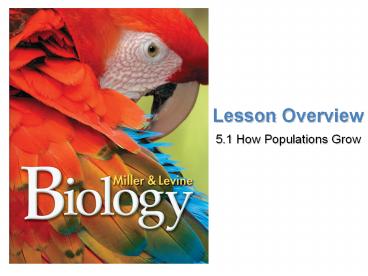Lesson Overview - PowerPoint PPT Presentation
1 / 22
Title:
Lesson Overview
Description:
Lesson Overview 5.1 How Populations Grow Describing Populations A population is a group of organisms of a single species that lives in a given area, such as the ... – PowerPoint PPT presentation
Number of Views:63
Avg rating:3.0/5.0
Title: Lesson Overview
1
Lesson Overview
- 5.1 How Populations Grow
2
Describing Populations
- A population is a group of organisms of a single
species that lives in a given area, such as the
hydrilla population represented on this map. - Researchers study populations geographic range,
density and distribution, growth rate, and age
structure.
3
Geographic Range
- The area inhabited by a population is called its
geographic range. - A populations range can vary enormously in
size, depending on the species.
4
Density and Distribution
- Population density refers to the number of
individuals per unit area. - Populations of different species often have very
different densities, even in the same
environment. - A population of ducks in a pond may have a low
density, while fish and other animals in the same
pond community may have higher densities.
5
Density and Distribution
- Distribution refers to how individuals in a
population are spaced out across the range of the
populationrandomly, uniformly, or mostly
concentrated in clumps.
6
Density and Distribution
- An example of a population that shows random
distribution is the purple lupine. These wild
flowers grow randomly in a field among other
wildflowers. The dots in the illustration
represent individual members of a population with
random distribution.
7
Density and Distribution
- An example of a population that shows uniform
distribution is the king penguin. The dots in the
illustration represent individual members of a
population with uniform distribution.
8
Density and Distribution
- An example of a population that shows clumped
distribution is the striped catfish. These fish
organize into tight groups. The dots in the
illustration represent individual members of a
population with clumped distribution.
9
Growth Rate
- A populations growth rate determines whether
the population size increases, decreases, or
stays the same.
10
Age Structure
- To fully understand a plant or animal
population, researchers need to know the
populations age structurethe number of males
and females of each age a population contains. - Most plants and animals cannot reproduce until
they reach a certain age.
11
Population Growth
- What factors affect population growth?
12
Population Growth
- What factors affect population growth?
- The factors that can affect population size are
the birthrate, death rate, and - the rate at which individuals enter or leave the
population.
13
Population Growth
- A population will increase or decrease in size
depending on how many individuals are added to it
or removed from it. - The factors that can affect population size are
the birthrate, death rate, and the rate at which
individuals enter or leave the population.
14
Birthrate and Death Rate
- A population can grow when its birthrate is
higher than its death rate. - If the birthrate equals the death rate, the
population may stay the same size. - If the death rate is greater than the birthrate,
the population is likely to shrink.
15
Immigration and Emigration
- A population may grow if individuals move into
its range from elsewhere, a process called
immigration. - A population may decrease in size if individuals
move out of the populations range, a process
called emigration.
16
Exponential Growth
- If you provide a population with all the food
and space it needs, protect it from predators and
disease, and remove its waste products, the
population will grow. - The population will increase because members of
the population will be able to produce offspring,
and after a time, those offspring will produce
their own offspring. - Under ideal conditions with unlimited resources,
a population will grow exponentially. - In exponential growth, the larger a population
gets, the faster it grows. The size of each
generation of offspring will be larger than the
generation before it.
17
Organisms That Reproduce Rapidly
- If you plot the size of this population on a
graph over time, you get a J-shaped curve
(exponential growth) that rises slowly at first,
and then rises faster and faster. - If nothing were to stop this kind of growth, the
population would become larger and larger, faster
and faster, until it approached an infinitely
large size.
18
Logistic Growth
- What is logistic growth?
- Logistic growth occurs when a populations growth
slows and then stops, - following a period of exponential growth.
- Natural populations dont grow exponentially for
long. - Sooner or later, something stops exponential
growth. What happens?
19
Phases of Growth
- Suppose that a few individuals are introduced
into a real-world environment. - This graph traces the phases of growth that the
population goes through.
20
The Logistic Growth Curve
- This curve has an S-shape that represents what
is called logistic growth. - Logistic growth occurs when a populations
growth slows and then stops, following a period
of exponential growth. - Many familiar plant and animal populations
follow a logistic growth curve.
21
Carrying Capacity
- When the birthrate and the death rate are the
same, and when immigration equals emigration,
population growth stops. - There is a dotted, horizontal line through the
region of this graph where population growth
levels off. The point at which this dotted line
intersects the y-axis represents the carrying
capacity.
22
Carrying Capacity
- Carrying capacity is the maximum number of
individuals of a particular species that a
particular environment can support. - Once a population reaches the carrying capacity
of its environment, a variety of factors act to
stabilize it at that size.































